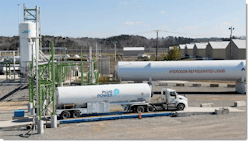Plug Power contracted to deliver 30-TPD H2 Liquefiers to Canada's TC Energy
Hydrogen and fuel-cell technology manufacturer Plug Power Inc. will deliver H2 liquefaction systems to Canadian infrastructure firm TC Energy.
The two, 30 tons-per-day hydrogen liquefiers will utilize an H2 refrigeration cycle to enhance energy density above gaseous H2. This liquefaction makes it more stable and dense for transport.
Plug Power moved into the H2 liquefaction segment with its 2022 acquisition of Joule Processing Inc. Plug is marketing the technology to customers and also utilizing the systems for its own nationwide network of green hydrogen generation plants in Texas, California and elsewhere.
“This deal validates our investment in Plug’s liquefaction capabilities as part of our vision to build an end-to-end green hydrogen solution,” Plug Power CEO Andy Marsh said in a statement. “We share TC Energy’s commitment to providing sustainable and secure energy, and together we look forward to accelerating the growth of the hydrogen market.”
The two hydrogen liquefiers are scheduled for delivery in second and third quarters of 2024 and will serve TC Energy facilities in North America that are not yet operational.
Hydrogen does not contain a carbon atom and does not emit CO2 when combusted. Although the lightest gas, It provides energy density to power generation and transportation technologies.
While it is increasingly sought after as possible future means of carbon-free power, hydrogen is not naturally available or mined and must be collected either through steam reforming of methane gas, a carbon-intensive method, or by using electrolyzers to split water. To be considered truly green H2, it must be created from electrolyzers powered by carbon-free resources such as hydro, wind, solar or nuclear.
TC Energy, known years ago as TransCanada Corp., works in the pipelines and energy infrastructure sectors. TC owns and operates the Keystone Pipeline system and the Bruce Nuclear Generating power station in Ontario.
Many companies are exploring a mix of hydrogen in gas-fired turbines to bring down carbon emissions in power generation.
In July, Canadian refiner Irving Oil contracted Plug Power to provide proton exchange membrance (PEM) electrolyzer equipment for producing and distributing hydrogen at the refinery in Saint John, New Brunswick.
-- -- --
(Rod Walton, senior editor for EnergyTech, is a 15-year veteran of covering the energy industry both as a newspaper and trade journalist. He can be reached at [email protected]).
Follow us on Twitter @EnergyTechNews and @rodwaltonelp and on LinkedIn.
About the Author
Rod Walton, EnergyTech Managing Editor
Managing Editor
For EnergyTech editorial inquiries, please contact Managing Editor Rod Walton at [email protected].
Rod Walton has spent 17 years covering the energy industry as a newspaper and trade journalist. He formerly was energy writer and business editor at the Tulsa World. Later, he spent six years covering the electricity power sector for Pennwell and Clarion Events. He joined Endeavor and EnergyTech in November 2021.
Walton earned his Bachelors degree in journalism from the University of Oklahoma. His career stops include the Moore American, Bartlesville Examiner-Enterprise, Wagoner Tribune and Tulsa World.
EnergyTech is focused on the mission critical and large-scale energy users and their sustainability and resiliency goals. These include the commercial and industrial sectors, as well as the military, universities, data centers and microgrids. The C&I sectors together account for close to 30 percent of greenhouse gas emissions in the U.S.
He was named Managing Editor for Microgrid Knowledge and EnergyTech starting July 1, 2023
Many large-scale energy users such as Fortune 500 companies, and mission-critical users such as military bases, universities, healthcare facilities, public safety and data centers, shifting their energy priorities to reach net-zero carbon goals within the coming decades. These include plans for renewable energy power purchase agreements, but also on-site resiliency projects such as microgrids, combined heat and power, rooftop solar, energy storage, digitalization and building efficiency upgrades.

